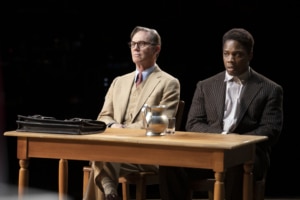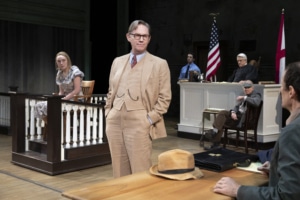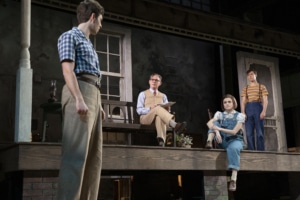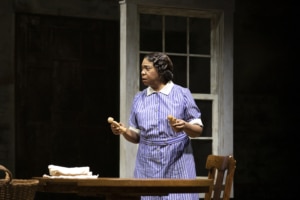DCPA NEWS CENTER
Enjoy the best stories and perspectives from the theatre world today.
Enjoy the best stories and perspectives from the theatre world today.
THE “SCOTTSBORO BOYS” TRIAL: POWELL V. ALABAMA (1932)
In this dramatization of Harper Lee’s To Kill a Mockingbird, Atticus makes reference to two US Supreme Court cases involving black boys and men accused of rape by white women. The verdicts of these two trials, Powell v. Alabama and Brown v. Mississippi, inform Atticus’s hope that Maycomb will not find Tom guilty, or if they do, that Tom will win his case on appeal.

Richard Thomas (Atticus Finch) and Yaegel T. Welch (Tom Robinson) in To Kill a Mockingbird. Photo by Julieta Cervantes
In 1931, nine young black boys between the ages of 13 and 19 were involved in an altercation with a group of white boys and two white girls while stowed away on a freight train in Jackson County, Alabama. They were all removed from the train and questioned by the police, at which point the two girls accused the black boys of rape. The boys were arrested and transported to Scottsboro, Alabama where they were charged with rape, a capital offense. In Scottsboro, they were met by a white lynch mob causing the governor to call in the National Guard. None of the boys were originally from Alabama and had no family or connections in the state. They were forbidden from contacting their families.
The boys’ trials proceeded with shocking speed: within two weeks of the alleged assault, all nine boys were arrested, tried, and convicted by an all-white jury. Eight were sentenced to death. Only the youngest’s verdict resulted in a hung jury. The International Labor Defense (ILD) took up the boys’ case and appealed first to the Alabama Supreme Court and then to the US Supreme Court. In 1932, the US Supreme Court overturned the case concluding the boys had not been provided with adequate legal representation during the trial.

(L to R) Arianna Gayle Stucki (Mayella Ewell), Richard Thomas (Atticus Finch), Stephen Elrod (Bailiff), Richard Poe (Judge Taylor), Greg Wood (Mr. Roscoe), and Joey Collins (Bob Ewell) in To Kill a Mockingbird. Photo by Julieta Cervantes
Although this was a landmark Supreme Court decision that established precedent for the appointment of counsel and proper protection of due process of the law under the 14th Amendment, it did not mean the end of the boys’ legal struggles. In fact, the Scottsboro boys would be involved in legal battles and trials for another six years, including a second case argued in front of the US Supreme Court, Norris v. Alabama. Ultimately, the convictions of five of the nine boys were upheld, even after one of the white women recanted her original testimony.
WALTER LETT TRIAL (1933)
The trial at the center of To Kill a Mockingbird was inspired by the details of a real rape trial that took place during Harper Lee’s childhood. In 1933, Walter Lett was accused of rape by a poor white woman, Naomi Lowery, in Lee’s hometown of Monroeville, Alabama. News of the trial was reported in The Monroeville Journal, which Lee’s father edited. Lett was found guilty by an all-white male jury and sentenced to death. However, his sentence was commuted by then Alabama Governor Benjamin Miller, who deemed the evidence to be insufficient. Unfortunately, the personal and mental strain of the trial triggered Lett’s mental illness. He was admitted to a mental institution when his sentence was commuted, and he died there in 1937 of tuberculosis.

(L to R) Justin Mark (Jem Finch), Richard Thomas (Atticus Finch), Melanie Moore (Scout Finch), and Steven Lee Johnson (Dill Harris) in To Kill a Mockingbird. Photo by Julieta Cervantes
BROWN V. MISSISSIPPI (1936)
Raymond Stuart was a white farmer in Kemper County, Mississippi who was beaten to death in his home in 1934. A mob of enraged white farmers quickly formed at his house. Within one week, three black tenant farmers — Ed Brown, Henry Shields, and Arthur Ellington — were arrested, tortured, forced to confess to the murder, tried, and sentenced to death by an all-white jury. The case was appealed with the combined aid and funding of the National Association for the Advancement of Colored People (NAACP), the Commission on Interracial Cooperation (CIC) and the Association of Southern Women for the Prevention of Lynching (ASWPL).

Jacqueline Williams (Calpurnia) in To Kill a Mockingbird. Photo by Julieta Cervantes
The case was overturned by the US Supreme Court in 1936 in a unanimous decision arguing that the confessions had been coerced. Chief Justice Charles Evans Hughes stated in his opinion, “The rack and the torture chamber may not be substituted for the witness stand.” Brown v. Mississippi laid the groundwork for Miranda v. Arizona in 1966, six years after To Kill a Mockingbird was published, which determined that all persons held by the police must be informed of their right to silence and their right to counsel before interrogation.
DETAILS
To Kill a Mockingbird
Jan 24-Feb 5 • Buell Theatre
Tickets
